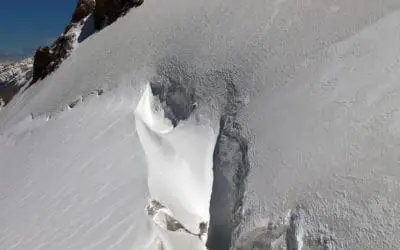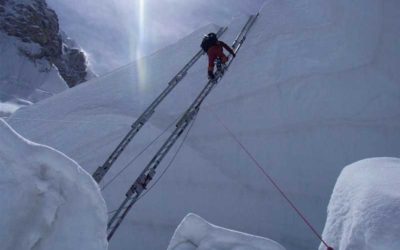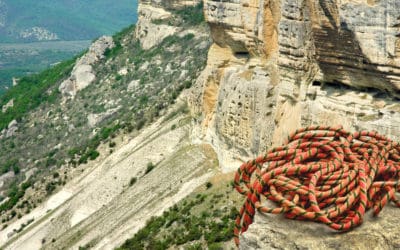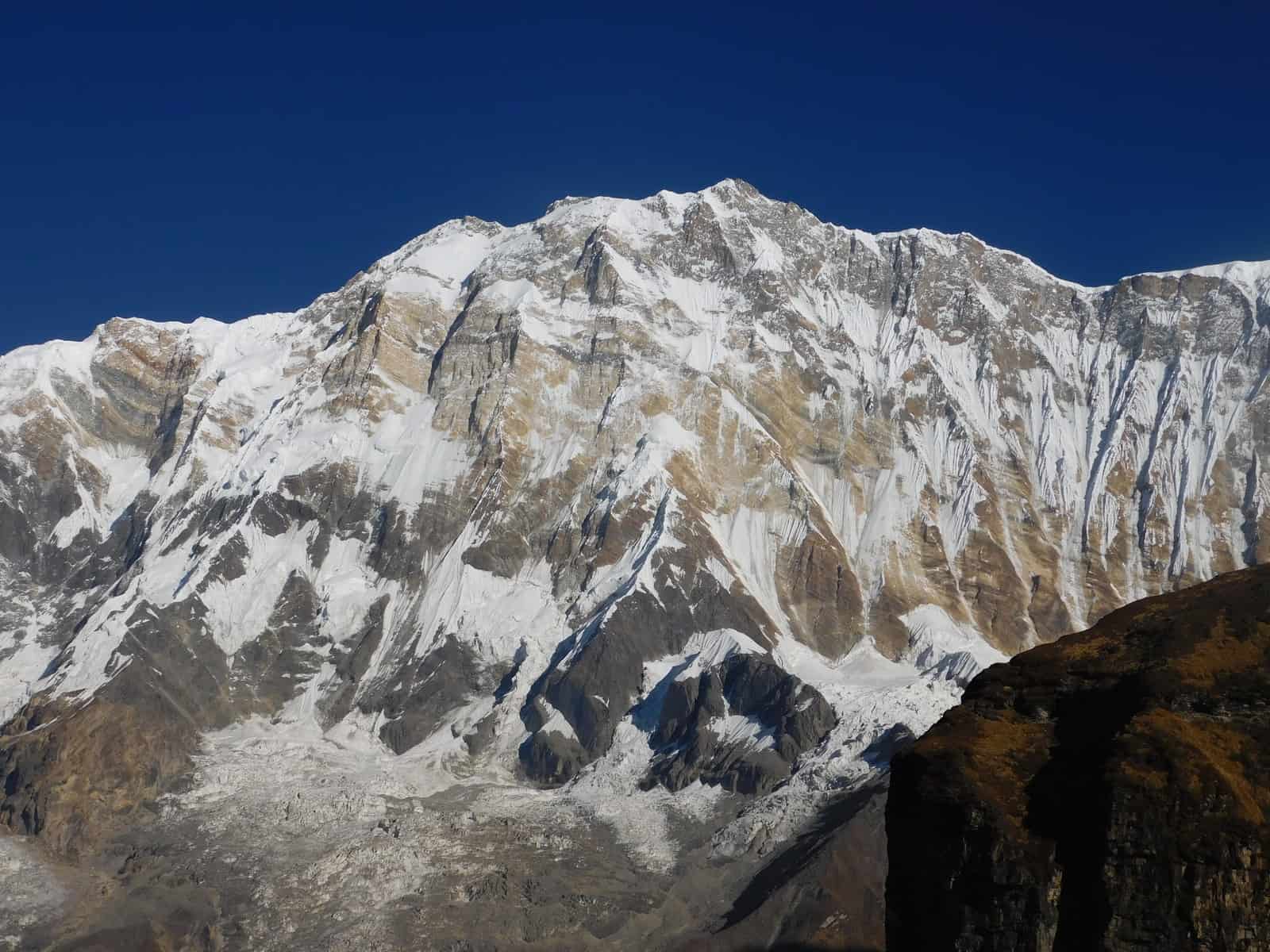
South Face of Annapurna I (Main). Photo from PrajwalMohan
Annapurna is known as the loneliest and deadliest peak in the world. At 8091 meters (26545 ft), this mountain in Northern Nepal is the tenth highest peak in the world. You would think that it would compare favorably to Everest, since it’s a much shorter climb at a lower altitude, but the route to the top in incredibly difficult and dangerous, so only elite climbers even attempt going there.
In summary, the main reasons why Annapurna is the deadliest mountain in the world are the frequent and unpredictable nature of avalanches, the unpredictable weather, the notoriously technically difficult terrain and the lack of support on the mountain.
In one of the biggest mountaineering disasters of our age, 39 people were killed in an avalanche on Annapurna in October 2014. Not the best advertisement when enticing people to the region.
Statistically, at 38% fatality rate, Annapurna is the most dangerous mountain to peak in the higher altitude range. It also has the lowest peak rate, with only 191 people reaching the top since 2012. Note that the fatality rate is somewhat misleading, since about a third of people who summit pass away. There are many more attempts that are aborted halfway through due to bad weather, fatigue or any other reason, most of who survive.
In this article, I will investigate why Annapurna is so dangerous and if there’s anything you can do to mitigate these dangers, if you’re brave (or maybe crazy) enough to try it (I’m not, yet anyway).
Here are the 4 main reasons why Annapurna is the most deadly and dangerous mountain in the world:
1. Avalanches on Annapurna
Annapurna is mainly considered dangerous due to its tendency to be avalanche-prone. This increases the dangers on an already highly technical route. Avalanches happen so often on this mountain that you can’t wait for a “safe avalanche window”, as you would on other mountains. You simply have to hope for the best when you start out.
If you’re in the path of an avalanche, your odds of survival are anyone’s guess. It probably depends on the severity of the avalanche and exactly where you encounter it. Unlike the Swizz Alps, where rescue teams are on hand when avalanches happen, there’s no support on Annapurna, so you’re really on your own.
2. Unpredictable Weather
Annapurna is much farther North than Everest. This causes the weather to be extremely unpredictable and notoriously foul. Snowfall and extreme cold are likely to occur all year round. Added to this, you’re likely to encounter severe snow storms, rain at lower altitudes and gale force winds.
Facing all of this could cause you to freeze to death, develop frostbite or simply slip and fall on the ice, tumbling down a crevice or getting seriously hurt on rocks. Not a fun thought.
The altitude of Annapurna places it squarely in the death zone (elevated more than 8000 meters above sea level), which means that you need oxygen when climbing it. Oxygen deprivation could cause you to blackout and even die. Death could be caused by actual oxygen deprivation or by exposure to the harsh weather conditions on the mountain.
3. Difficult Terrain
Annapurna’s terrain is notoriously difficult and technical. The slopes are far steeper than that of Everest and the routes to the top are not easy to traverse. There are also no fixed ropes, as I mentioned earlier. This means that no one goes ahead of you to prepare the route, as would be the case on Everest.
You have to map it out for yourself and navigate it too. If you get lost or your GPS stops working, you’re in deep trouble.
Visibility can be very low in the severe weather on Annapurna, increasing the risk tripping and falling down steep slopes or ravines and landing on rocks.
Meters above ocean level
%
Fatality rate of people who summited
People who summited 2012-2019
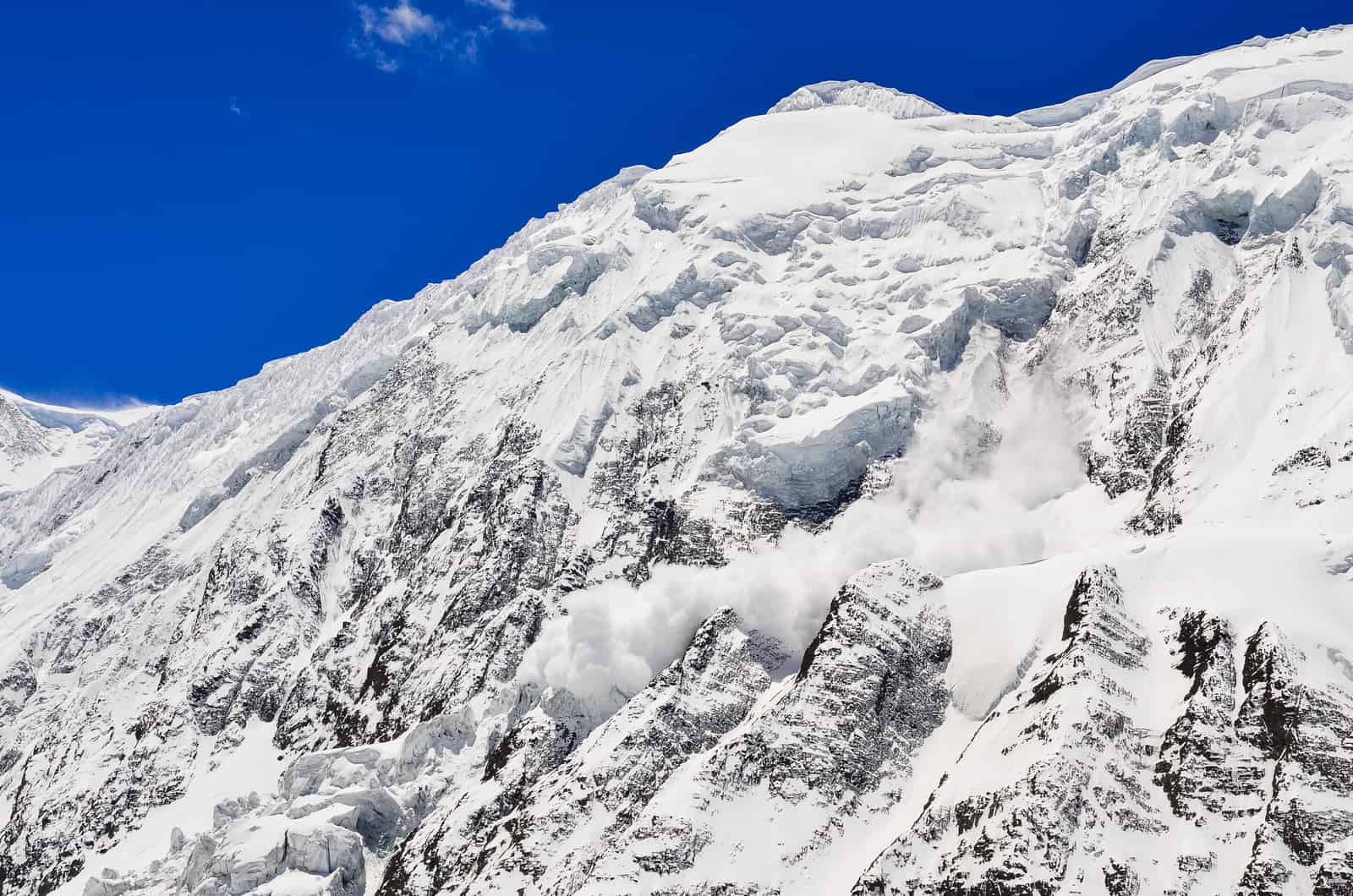
4. Lack Of Local Support/Accessibility
Another factor adding to the dangers of Annapurna is the location. It’s actually not a single peak, but a 60km long mountain range with various peaks. It has a total of fourteen peaks over 7000 meters and another sixteen above 6000 meters. This range is difficult to approach and local support is hard to come by, so if anything goes wrong, you’re basically on your own.
Compare this to Everest, which is easy to approach and has a crazy amount of local resources nearby and it starts to make sense that even highly experienced mountaineers think twice before taking on any of the Annapurna peaks.
Here, there are no Sherpas or fixed ropes, so there’s really no back-up when things go wrong or help on technical parts of the route. If you’re caught in an avalanche, you and your team will have to dig yourselves out, if you can. This could take a long time and prolongs your exposure to extreme conditions.
Also, no one is going to set up camp and prepare your meals for you. You have to carry everything you need with you, on your own back, and hope you brought enough. This includes tents, food, medical supplies, oxygen, crampons and whatever other gear you need.
Added to all of this, you will have to start hiking at quite a low altitude, since there’s very little infrastructure in the area. Driving will get you closer to base camp, but not nearly as close as you can expect at Everest.
Mitigating The Risks
Annapurna is, in essence, a dangerous place. There are some things you can do to mitigate the risks. In the end, however, the combination of extreme weather, avalanches and lack of local support makes this one of the most dangerous undertakings you can ever attempt. If you’re really set on taking on Annapurna, consider the following:
Always take a trained medical person as part of your team. You’re likely to encounter frostbite, altitude sickness and even broken bones on your way, so having someone who can treat you immediately and effectively is vital. If possible, have everyone on your team trained in advanced first aid, since your team doctor might end up getting hurt as well.
Train properly. Only elite mountaineers take on Annapurna and still the fatality rate is alarmingly high. Before you try it, climb other difficult and technical mountains and make sure that you’re in top shape (mentally, physically and technically) for this monster.
Plan in minute detail. If you forgot anything, there’s no turning back to fetch it and no one you can borrow it from. Forgetting some small part of your gear or making a mistake when laying out your route could cost you dearly. Think of every possible thing that could go wrong on the mountain and prepare for it as best you can.
Conclusion
Annapurna is a dangerous place and should not be attempted by inexperienced or unprepared climbers. While there are some precautions you can take to mitigate the risks of the mountain, you’re really up against luck and everything nature can throw at you.
If you’re one of the brave and lucky few to summit Annapurna and live to tell the tale, let me know.
Written by Felix

About me
Hi! I’m Felix. When I’m not spending time out in the mountains, I like to write about my hobbies. That is how Mountain Homies was created. On this site, I try to gather all the juicy information about Mountaineering that I have learned since I started. Happy adventures!
Related Articles
3 Ways to Spot and Reveal a Crevasse (And Avoid It)
So, how do you spot a crevasse and – more importantly – avoid falling into one? In this article, I will have a look at what crevasses are and how to detect them…
3 Clever Ways of Crossing A Crevasse
When you’re mountaineering in snow country, you will undoubtedly encounter some crevasses. These are scary, since you don’t always spot them…
Mountain Climbing vs Rock Climbing: 5 Biggest Differences
The key differences between rock climbing and mountain climbing are the gear requirements, environmental risk, geographical locations, weather and…
Stay Up to Date With The Latest News & Updates
Join Our Newsletter
The owner of this site is a participant in the Amazon Services LLC Associates Program, an affiliate advertising program designed to provide a means for sites to earn advertising fees by advertising and linking to amazon.com.

